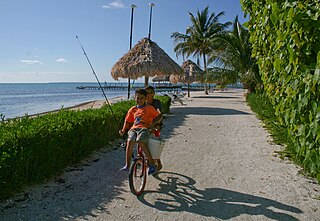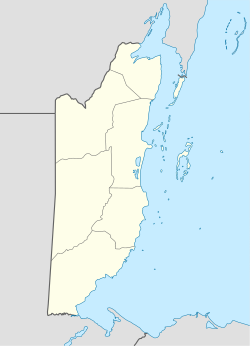
Demographics of the population of Belize include population density, ethnicity, education level, health of the populace, economic status, religious affiliations and other aspects.

Orange Walk Town is the fourth largest town in Belize, with a population of about 13,400. It is the capital of the Orange Walk District. Orange Walk Town is located on the left bank of the New River, 53 miles (85 km) north of Belize City and 30 miles (48 km) south of Corozal Town. Despite the English name of the city, its residents are primarily Spanish-speaking mestizos. The city is in a very low-lying area of Belize, though the police station sits atop a buried Mayan pyramid at 49 m (161 ft) tall.

Corozal District is the northernmost district of the nation of Belize. The population was 33,894 in 2000. The district capital is Corozal Town.

Orange Walk District is a district in the northwest of the nation of Belize, with its district capital in Orange Walk Town.
Guinea Grass is a village in the Orange Walk District of the nation of Belize. It is 38 metres above sea level. According to the 2000 census, Guinea Grass had a population of 2,510 people; by 2010 the census figures showed a population of 3,500. The population is made up of mostly Mestizos, Creoles, and East Indians. There are a number of Mennonites, Taiwanese and other Central American immigrants living near or immediately in the village.
Trial Farm is a village near Orange Walk Town in the Orange Walk District of the nation of Belize. According to the 2000 census, it had a population of 3,443 people. It is located at 29 metres above sea level.
Xaibe is small rural settlement in the country of Belize mainly consisting of people from the Yucatec Maya ethnicity. It is located in Corozal District. The name Xaibe literally means 'crossroads'. The people of the Maya civilization often traversed across the village to reach other Maya villages. The population of the village is very small. The last available data of the population of Xaibe in 2010 revealed that it had a modest population of approximately 1,575 people. There is, however, evidence of the fact that the people belonging to the Maya civilization resided in the Xaibe village. These people then gradually shifted to Mexico, just across the border at the time of the Caste War of Yucatán. The village is known for celebrating the Maya tradition Hanal Pixan which means "food for the souls" also known as Day of the Dead.
Chunox is a village located in the Corozal District of Belize, with a population of 1,143 people. It is primarily an agricultural community surrounded by sugar cane fields, and is located on the east bank of Laguna Seca. The official language is English, but most residents speak Spanish due to their Maya Mestizo ancestry. St. Viator Vocational High School serves the village. There are several Maya residential mound groups in Chunox from the Classic Period. Copper Bank, a fishing village, is situated across the lagoon from Chunox.

San José is a village in the Orange Walk District of Belize. In the 2000 census, San José had a population of 2,254 people. The village is the fourth largest in the Orange Walk district and is estimated to have almost 3,000 residents as of 2016 mainly of Yucatec Maya-Mestizo ancestry. San José is adjacent to San Pablo and is only divided from the latter by a speed bump. Combined, the two villages make up the third largest population center in the Orange Walk District with approximately 4,000 residents.

According to the 2010 census, the major languages spoken in Belize include English, Spanish and Kriol, all three spoken by more than 40% of the population. Mayan languages are also spoken in certain areas, as well as German.

San Joaquín is a village in the Corozal District of Belize. It is one of the largest villages in Corozal. The town was formed as a result of Mestizos migrating to escape the 1847–1901 Caste War of Yucatán.
Sarteneja is the largest fishing community and the second largest village in Belize. It recorded a population of 3,500 according to a 2016 estimate. The name Sarteneja is a Castilian distortion of its original Mayan name Tza-ten-a-ha, which means 'water between the rocks'.

Copper Bank is a fishing village in the Corozal District of Belize. It is situated on the west bank of Laguna Seca, a shallow lagoon that empties into Chetumal Bay just north-east of the village. The closest settlement is Chunox, located approximately 1.25 miles away on the east bank of the Laguna Seca.

La Milpa is an archaeological site and an ancient Maya city within the Three River region of Northwest Belize bordering Mexico and Guatemala. La Milpa is located between the sites of Rio Azul and Lamanai. Currently, La Milpa lies within the nature preserve owned by the Programme for Belize, a non-profit organization. PfB acquired land for the preserve from the Coco-Cola Company, who purchased land in Belize in 1988 with the goals of tearing down the rainforest to create a citrus plantation, however donated the land to conservation and management project in 1990 and 1992. Following Caracol and Lamanai, La Milpa is the third largest site in Belize with the Main Plaza alone covering 18,000 square meters, making it one of the largest in the entire Maya region.

Hispanic and Latin American Belizeans are Belizeans of full or partial Hispanic and Latin American descent. Currently, they comprise around 52.9% of Belize's population.
Chan Chen is a village located in Corozal District, Belize. Most of the inhabitants speak Spanish or Yucatec Maya, along with some English. The name Chan Chen is Yucatec maya meaning "small well" in English. Most Chan Chen inhabitants are of Maya ancestry.
Indian Creek is a Mennonite settlement that is also an administrative village in Orange Walk District in Belize. Its inhabitants are German-speaking so called "Russian" Mennonites.
Yo Creek is a small village located in the Orange Walk District of the nation of Belize, consisting mainly of people of Yucatec Maya descent. The name Yo Creek comes from the combination of the Maya word yo which means "top" and the English word creek. Most Yo Creek residents speak Spanish and English very well, while the elders still speak their Maya language. Yo Creek is well known for cultural programs to preserve the Maya Yucatec culture. The village is also known for their Poktapok Maya ball game team Ek' Balam which means in the Yucatec Maya language Black Jaguars who won the championship in El Mundo Maya mundial de PoktaPok 2017.











